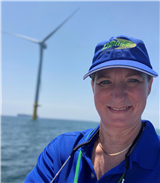 Jennifer K. Palestrant, Chief Deputy of Virginia Department of Mines Minerals and Energy
Jennifer K. Palestrant, Chief Deputy of Virginia Department of Mines Minerals and Energy
There is a fresh wind blowing in Virginia. This spring, Dominion Energy and Orsted installed the first two offshore wind turbines in Federal waters, located 26 nautical miles off the coast of Virginia Beach. These turbines are used to research new technologies aimed at lowering the cost of energy production.
As Dominion Energy has now announced, planning is underway to build the largest offshore windfarm in the United States off the coast of Virginia. By 2028, it will provide 2.6 gigawatts (gw) of energy annually: enough to power 650,000 homes.
In this emerging field, Hampton Roads has very real, natural advantages over our sister states to the north. Not only are we home to the largest naval base in the world and the fourth largest port in the US, but we also have deep channels, no overhead air obstructions, an ice-free harbor, and ample land for lay down space.
Each wind turbine is taller than the Washington Monument and has blades longer than a football field. Structural steel comprises the greatest weight in a turbine. To build one employs those skills already used in the ship building and ship repair industry. These skills needed in the wind industry include computer-aided design, precision machining, fitting, welding, surface preparation and coating. Due to the large size of the turbines, these trades must be exercised on mobile lifts or on fixed scaffolding similar to the lifts and scaffolding used by shipyards to access high areas on a hull or deckhouse module.
Numerous local and state organizations are working to expand the entire maritime workforce across the Commonwealth, of which Offshore Wind is a sector. Virginia has the largest and most highly-skilled maritime workforce in the United States. The plan is to expand the number of people who hold certification in skilled trades. This workforce will be needed for varied industries including tunnel construction, ship building, ship repair, and wind turbine manufacturing. There are 6,000 moving parts to a wind turbine. Depending on how much of the supply chain we are able to draw to Virginia, we are expecting to create between 5,000-15,000 new jobs in the industry.
Virginia’s 2020 General Assembly session was pivotal to the success of this new industry, resulting in both a state policy supporting renewable energy and a major utility power purchase agreement. Without these, offshore wind cannot grow. The Virginia Clean Economy Act is momentous: the first Omnibus Renewable energy bill in the South. The bill calls for 100% renewable electrical generation by 2045. This includes 5.2 gz of offshore wind, enough to power every home from Richmond to Virginia Beach.
Another noteworthy bill, created the Virginia Division of Offshore Wind within the Department of Mines, Minerals and Energy. This division will be the first of its kind in the nation and will serve as a clearinghouse for all offshore wind activities, training, research and economic development.
Maritime is the backbone of our nation’s global trade, pivotal to our domestic "blue highway" shipping industry, critical to supporting our nation’s military and security, and one of the largest employers in the United States. Offshore wind is a perfect complement to the greater maritime industry, bringing critical economic diversification and new opportunities to Virginia.
In October 2019, Virginia’s Governor Ralph Northam appointed Jennifer Palestrant as Chief Deputy of the Department of Mines, Minerals & Energy, overseeing the development of offshore wind for the Commonwealth. Jennifer most recently served as Director of the SMART Center at Tidewater Community College and as a Senior Vice President at the Hampton Roads Chamber of Commerce.

On June 29 in Virginia Beach, Governor Ralph Northam signed legislation to spur the development of offshore wind in Virginia and create the Office of Offshore Wind within the Department of Mines, Minerals, and Energy.

The first two wind turbines built in federal waters, located 26 nautical miles off the coast of Virginia Beach.
« Return to Newsletter